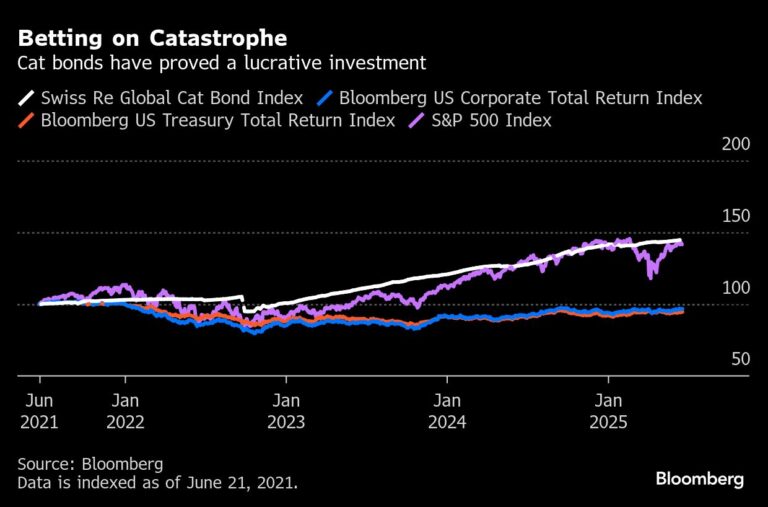One of the most successful hedge fund strategies in recent years—insurance-linked securities—is embracing a classic concept that has suddenly surged back into favor.
Parametric insurance, which provides swift payouts when specific weather-related thresholds are triggered, was once mainly limited to small businesses and farmers in developing regions. Today, it’s a fast-expanding market attracting major corporations throughout the developed world.
Sebastien Piguet, co-founder and chief insurance officer at Descartes Underwriting, explains that parametric models are addressing a gap left by traditional insurance policies, especially as climate change and the rise of extreme weather events increasingly strain conventional coverage frameworks.
“It’s much more challenging to find capacity for this kind of coverage with traditional insurance,” he said.
Companies now turning to parametric insurance include French pharmaceutical giant Sanofi SA, telecom operator Liberty Latin America, and renewable energy investor Greenbacker Capital Management. The market for these products is projected to nearly double, reaching $34 billion by 2033.
This shift has drawn the attention of ILS investment managers. Insurance-linked securities—ranked by Preqin as the top-performing hedge fund strategy of 2023—have traditionally centered on catastrophe bonds. These bonds, usually issued by insurers and reinsurers, reward investors if certain triggers, such as wind speed or insured losses, aren’t reached, but result in losses if those thresholds are exceeded.
In recent years, this model has delivered returns that consistently outpaced the broader market.

Parametric insurance-based investment funds have the potential to outperform catastrophe bonds, according to Rhodri Morris, portfolio manager at Twelve Securis. The Zurich-based alternative investment firm, which manages $8.6 billion and specializes in cat bonds, teamed up with Lumyna Investments in February to launch the Lumyna-Twelve Capital Parametric ILS Fund.
“We aim to return a couple of percentage points above the cat bond market,” Morris said in an interview.
As the first fund of its kind, it has already attracted around €85 million ($99 million) in capital. Morris expects that figure could grow to as much as €200 million by next year.
One major draw for investors, Morris notes, is the ability to avoid so-called trapped capital. In catastrophe bonds, investors can be left waiting months—or even years—for loss assessments and payout resolutions. In contrast, parametric funds typically provide clarity within days, as payouts are triggered by predefined metrics rather than lengthy claims processes.
The Lumyna-Twelve parametric fund has attracted 'genuine interest' from investors, according to Morris. However, he noted that it has also prompted a range of questions, with several key considerations investors need to weigh.
“Investors need to understand that you’re giving up liquidity in some part of the portfolio,” Morris said. “But the benefits you’re getting are higher returns and the lack of trapping.”
The fund secured seed capital from what it describes as a "top-tier European institutional investor," though Morris declined to disclose the firm’s identity.
Luca Albertini, CEO of Leadenhall Capital Partners—a London-based firm managing $4.5 billion in ILS assets, including several private parametric deals—says that while parametric products offer investors transparency and rapid payouts, careful selection is essential.
“The attractiveness of parametric comes and goes,” and “you need to be watchful that the risk-reward remains attractive compared to alternatives in the same space,” such as cat bonds, he said.
The Lumyna-Twelve fund will be structured to allocate a portion of its capital to deals it originates directly. For these transactions, it will rely on Descartes for structuring, while Assicurazioni Generali SpA — Lumyna’s parent company — will supply the insurance capital to back the products.
Returns will also come from parametric deals executed by Descartes and its partner Generali for their own clients. These deals will be pooled together, allowing the Lumyna-Twelve fund to invest in a portion of the final bundled product.

Homes surrounded by floodwater after Hurricane Beryl made landfall in Sargent, Texas, on July 8, 2024.
Photo credit: Eddie Seal/Bloomberg
Climate-related economic losses in the U.S. have totaled $6.6 trillion over the past 12 years, making the challenge of managing extreme weather events not just an environmental issue, but a "significant financial concern," according to a recent Bloomberg Intelligence report.
Amid this backdrop, corporate demand for parametric insurance continues to rise. Cyril Lelarge, global head of insurance at Sanofi, explains that the company is increasingly turning to parametric coverage to protect its supply chain. “It’s important for us to protect our assets for the future,” he said.
Liberty Latin America reported purchasing "several hundred million dollars" worth of hurricane parametric insurance in 2024. When Hurricane Beryl struck last July, the company received a swift payout of $44 million, which aided in rebuilding its damaged infrastructure.
Descartes has also introduced parametric coverage for solar farms against tornado damage. Meanwhile, insurance broker Aon Plc, in collaboration with Swiss Re and Floodbase, has launched a policy addressing hurricane-related storm surge along the U.S. coast. Additionally, Axa SA has developed a product to protect outdoor workers in Hong Kong from heat waves.
Parametric insurance is gaining traction among renewable energy companies, with solar plants in Texas securing coverage against hailstorms and wind farms using these policies as a financial safeguard against revenue losses when the wind fails to blow.
For Greenbacker Capital Management, the parametric coverage provided by Munich Re, combined with a "wind proxy hedge" structured alongside kWh Analytics, played a key role in attracting lenders, according to Dan de Boer, interim CEO of Greenbacker.
“It allowed us to raise 20% more debt capital” for a US wind project, he said.






































